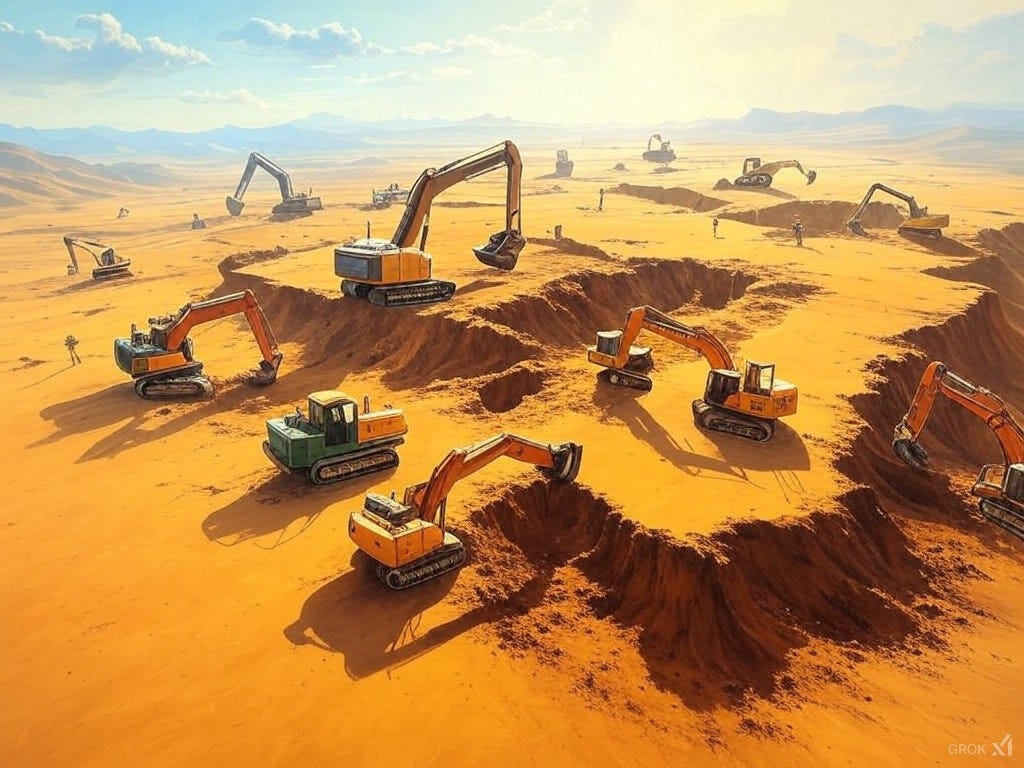From Plateau to Panorama: Sculpting the AI Landscape
Imagine standing on an endless, flat plateau under a vast sky. This plateau represents an untrained AI model, devoid of structure, where every prediction is as meaningless as the next. It's not entirely featureless; there are minute, random bumps and indentations, akin to the random initialization of weights in neural networks, giving our starting point a bit of character. But overall, it's a uniform expanse, waiting to be shaped.
The Initial Digging: Carving Understanding from Chaos
Training begins, and we're not just walking through this landscape; we're actively transforming it. Each piece of training data is like a handful of earth, either being added or removed, slowly sculpting this plateau into something meaningful:
The Loss Function: This acts as our sculptor's eye, identifying where the landscape needs to be reshaped. High loss indicates areas to dig deep, creating valleys where our model will perform well.
Gradients: They guide our hands, telling us where to carve next. We follow these gradients to chisel away at the plateau, aiming for lower loss, which forms the first signs of valleys and hills.
Learning Rate: Think of this as choosing the right shovel or chisel. Too large, and we might make rough, hasty cuts into the land; too small, and our progress is painstakingly slow, but precise.
Shaping with Diverse Tools
We employ a variety of tools for this transformation:
Momentum: Like using a pickaxe to break through stubborn rock, momentum helps us move larger amounts of material at once, pushing through areas that resist change.
Regularization: This technique is like having a sander at hand, smoothing the landscape to prevent us from creating overly intricate features that fit only the training data (overfitting).
Batch Normalization: Occasionally, we level parts of the ground to keep our sculpting consistent, counteracting the shifts that occur as the landscape evolves.
Dropout: Sometimes, we block off certain areas or tools, ensuring that our model doesn't rely too heavily on any one path, promoting resilience and generalization.
The Dynamic Environment
The landscape doesn't stay static:
Weathering: Over time, the environment changes - new data, different distributions, perhaps even shifts in what we're trying to predict. This requires us to adapt our sculpting techniques or even reshape parts of our landscape we thought were finished.
Human Guidance: Just as architects guide construction, data scientists and engineers adjust our approach, deciding when to switch tools, when to stop digging, or where to focus our efforts next by tweaking hyperparameters or choosing when to use techniques like dropout.
Exploring vs. Exploiting
Scouts: We send out scouts to explore different parts of the plateau before deciding where to dig. This reflects the balance in machine learning between exploring new areas (which might lead to better solutions) and exploiting what we've already learned (refining current understanding).
Validation and the Art of Generalization
Checkpoints: Regularly, we measure our progress against a known map (validation data). This ensures we're not creating features that only work for our immediate work area (overfitting).
Unseen Terrain: The true test comes when we navigate new, unseen areas with our sculpted landscape. Here, the model must generalize, proving that the valleys and paths we've created aren't just for the training data but for real-world scenarios.
Efficiency in Shaping
Energy and Time: This sculpting process isn't just about achieving the right shape; it's about doing so efficiently. Some methods might sculpt faster but with less precision, while others might take longer but yield a more accurate representation of the data.
The Final Art Piece
After months, perhaps years of meticulous work, what emerges is not just functional terrain but a piece of art:
A Beautiful and Practical Landscape: Our model now represents a rich, detailed panorama where valleys signify areas of high performance, hills show where challenges remain, and the overall topography beautifully captures the essence of the data it was trained on.
This journey from a flat, meaningless plateau to a detailed, navigable landscape encapsulates the essence of training AI models. It's a process of creativity, precision, and sometimes, brute force, guided by both the data we feed into our models and the sophisticated techniques we use to mold it into something that can understand, predict, and perhaps even inspire.



